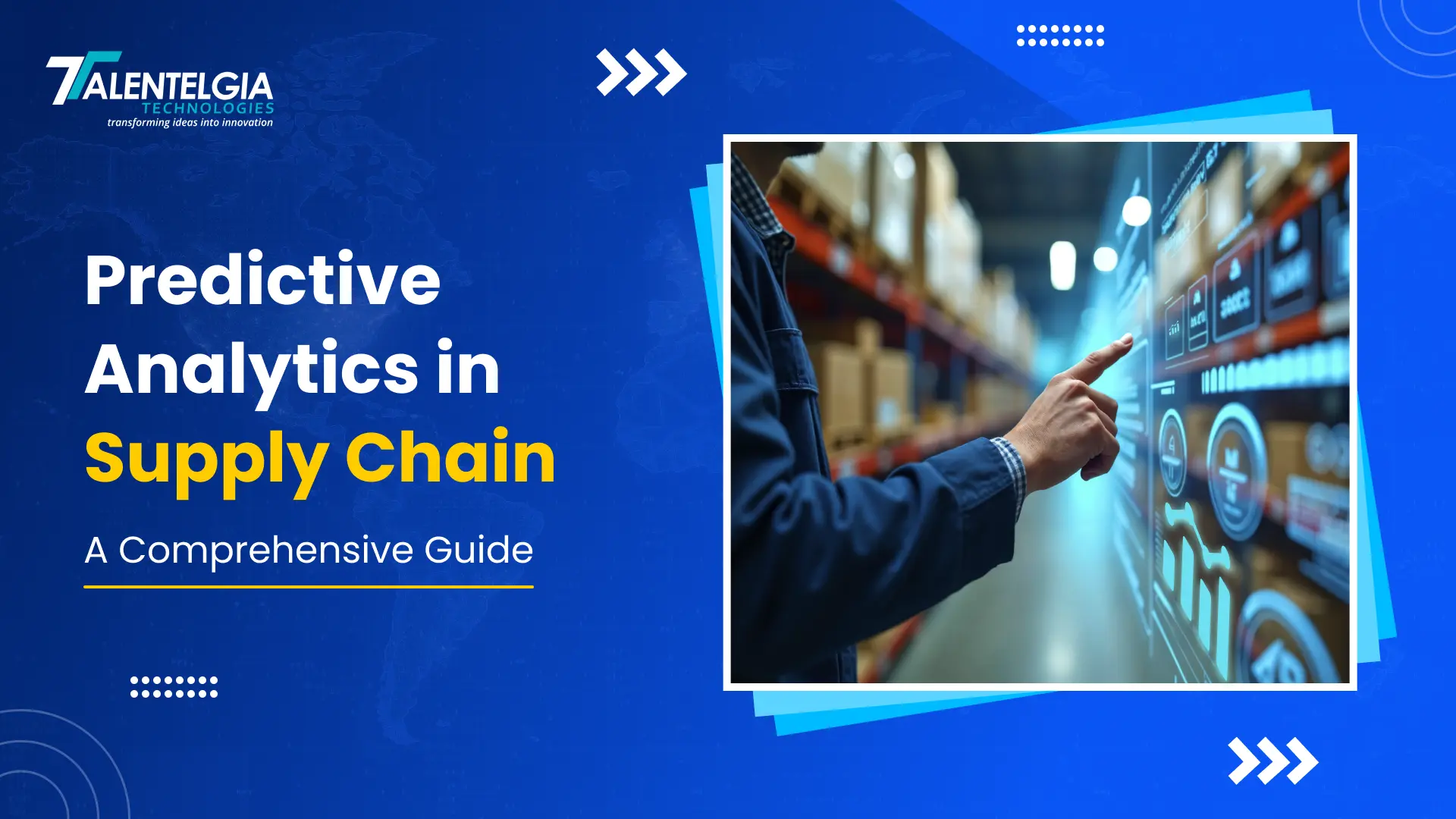Predictive analytics is changing how business navigates supply chains by taking into account economic instability, geopolitics, and natural catastrophes. Predictive analytics gives companies the power to be one step ahead of disruptions to predict problems, optimize processes, make proactive decisions, and create improvements in efficiency and resiliency by using data from history, machine learning algorithms, and real-time insights from these systems.
Did you know? It is estimated that “global supply chain disruptions cost large companies an average of $182 million annually,” claims Interos Annual Global Supply Chain Report. The need for making predictive analytics a part and parcel of supply chain management has therefore never been so important as today. And why not? This transformational technology equips companies to anticipate risks, streamline operations, and reduce costs incurred.
Let’s discuss this in detail. For this, we’ll first cover the fundamentals of predictive analytics in the supply chain, how these concepts matter, and the various benefits and challenges that you might face while integrating this technology into your business. Let’s dive right in!
What is Predictive Analytics?
Predictive analytics is among the advanced data analysis methodologies that use algorithms, machine learning, and past data to predict future events or trends.
It forms a major component of data science, which, with the rise of big data systems that have come into existence, can store and process big data sets. However, in conjunction with the volume of data available, companies can mine this data to find beneficial patterns for long-term business needs.
For instance, predictive analysis enables companies to predict future disruptions in the supply chain industry. A retail business might use predictive analytics to analyze historical sales data, seasonal trends, and external patterns like weather patterns. They could then predict certain times of the year when demand for specific products may increase, hence allowing optimization of the inventory levels, prevention of stockouts, and excess stocks.
Besides prediction, predictive analytics allows for the development of personalized customer experiences and enhances supplier relationship management and supply chain visibility. In this manner, businesses are better equipped to react to changes in demand by being able to prepare for the future through real-time data and predictive models.
How Does Predictive Analytics Work in Supply Chain Management?
Predictive analytics in supply chain management uses past data and market trends to predict future outcomes and potential risks. By leveraging advanced supply chain management tools like AI and machine learning, businesses can better understand demand patterns, supplier performance, and operational inefficiencies. This helps optimize inventory, improve logistics, and prepare for disruptions. It empowers suppliers to make proactive decisions, boosting efficiency and reducing risks.
To better understand how predictive analytics works, let’s examine some real use cases that show the transformation that can be achieved through its application.
Demand Forecasting
Accurate demand forecasting is the most crucial element of supply chain management. It makes sure that a business has just enough inventory without wasting its resources. Historical data plays a very important role in analyzing this demand.
From an analysis of past sales, a company can forecast its most probable high-demand items. Data collection and storage methods help a business understand and predict its sales trends based on promotional activities, the weather, and other demand influencers.
Prediction models help firms account for seasonality, economic factors, and consumer behavior to ensure accurate projections of future demand. This information helps companies make optimized inventory decisions supporting customer needs.
For example, if history shows that cereals sell more during the winter season, the shop can prepare in the fall by ordering more supplies. This way, the supply chain is optimized, with less chance of overstocking or understocking, and customer expectations are still met. Predictive analytics can help a supermarket improve its operational efficiency and avoid potential losses.
Logistics Optimisation
The basic concept of logistics is the ability to control the movement of products. This way, logistics ensures that the products are delivered in perfect condition. Hence, it is crucial for the general improvement of supply chain performance.
Predictive data analytics impacts the logistics and supply chain significantly. Companies analyze historical shipping data, traffic patterns, weather conditions, and other factors and pinpoint the most efficient route and transportation mode. Thus, cost-effectiveness, improved customer satisfaction, and strong supplier relationships are realized.
It also helps manage risks because it can predict potential disruptions from suppliers, natural disasters, or transportation-related issues. Advanced analytics enable companies to be proactive about bottlenecks and prevent delays.
An example could be the food industry; if there is a delay or ineffective transportation, then the quality and freshness of the products might not be guaranteed. Predictive analytics helps supply chain managers to optimize fleet performance in shipping routes, weather conditions, and traffic patterns.
Risk Management
Predictive analytics helps identify potential risks before they affect a supply chain. Analyzing present and historical data predicts disruptions and allows advanced action to minimize exposure.
Besides risk identification, predictive analytics helps track critical supply chain metrics, such as delivery times, inventory levels, and production output. This will help businesses focus on areas of improvement and ensure better performance over time.
Predictive models are also improving maintenance strategies. Predictive maintenance analyzes data from sensors and other sources to foretell equipment failures. Such proactive maintenance scheduling decreases downtime and costly repairs in any company.
Keeping commodity production on schedule requires a consistent input of raw materials and other supplies for the manufacturing business. Predictive analytics lowers risks in supply chains, as it concerns supplier-related data, transport route data, and logistics data.
For instance, a manufacturer can use predictive models to determine supplier performance based on lead times, quality metrics, and delivery reliability. In the same way, analyzing machine performance and maintenance schedules can optimize production output and minimize downtime for smoother operations.
Cost Optimization
It arises due to various factors, including supply and demand. For example, gasoline prices are bound to escalate during holidays or weekends when demand is at its highest.
Manufacturers can benefit from predictive analytics by analyzing historical data regarding product volume sales, market conditions, changes in currency, and inflation. Based on this analysis, predictive models provide optimal pricing strategies.
Predictive analytics also lowers the risk of “pricing errors” because of manual calculations or delayed access to the appropriate data. Automating the pricing process allows businesses to ensure that they make the best decisions at their disposal and optimize their competitive advantage.
Predictive models can be used to determine baseline predictions based on historical data and current market trends. This way, supply chain managers could precisely predict pricing strategies, helping them decide whether to offer discounts or increase profit margins based on prevalent market conditions.
Benefits of Implementing Predictive Analysis in Supply Chain Management
Predictive analytics has improved supply chain efficiency and performance in different industries. It helps predict demand, optimize inventory, and eliminate operational inefficiencies by giving AI-driven insights.
The benefits of applying predictive analytics in supply chain management can be categorized into four broad areas:
Better Decision-Making
Predictive analytics uses historical data and industry trends to let organizations make better decisions regarding inventory levels, staffing, and resource allocation. Therefore, the company may get more accurate forecasts, optimize financial performance, and reduce losses arising from poor planning.
Risk Reduction and Business Resilience
Predictive analytics allows the business to predict possible disruptions ranging from supplier delays to market fluctuations. Once these risks are identified early, proactive steps can be taken, thus making the supply chain resilient and adaptable to change.
Cost Savings and Revenue Maximization
Businesses can eliminate excess stocks, and minimize stockouts and missed sales by ensuring accurate demand forecasting and inventory optimization. With predictive models that help match supply with demand, better versions of optimal pricing strategies can be implemented.
Customer Satisfaction
By analyzing consumer behavior and market trends, businesses can better understand their customers’ needs and anticipate them. This helps create personalized marketing strategies and target campaigns and increase product availability. This not only fosters customer loyalty but also drives sales through offerings that match actual demand.
Challenges of Predictive Analytics in Supply Chain Management
The simplest predictive analytics solutions have been around for decades, but huge challenges are associated with moving toward complex and more powerful machine learning-based forecasting systems.
Let’s understand some of the major challenges that are faced while integrating predictive analytics with supply chain management.
Limited Access to Historical Data
One of the big drawbacks to adopting predictive analytics is that it requires very high levels of historical data on which to build robust models. For predictive analysis to operate, organizations have to collect reliable data spanning some time across business units or with supply chain partners.
The quality of collected data depends entirely on company size, geographic reach, and current IT infrastructure. Often, a full data investigation should be done before the predictive models can be deployed, which requires advanced data scientists to ensure data integrity and relevance. In contrast, companies should invest first in gathering strategically valuable data by starting cost-efficient AI Design Sprint workshops to initiate the process of gathering data and starting the process of predictive modeling.
Limited 360° View of the Supply Chain
Many organizations still rely on the old, siloed systems that do not provide any integrated view of the entire supply chain network. Legacy systems often fail to provide an all-around view of operations, complicating data-sharing and decision-making processes. Data merging and analysis across multiple systems is challenging when software solutions from different vendors cannot seamlessly integrate. One of the biggest obstacles before the successful application of predictive analytics in modern businesses is a unified, holistic view of the supply chain.
Few AI-Skilled Experts
There is a significant shortage of AI developers with experience in machine learning and predictive modeling. While top-level companies can engage data scientists or machine learning experts, businesses are facing severe challenges regarding the availability of qualified people with deep technical expertise and a good grip on the respective industry knowledge. Such talent scarcity is one reason they cannot successfully deploy predictive analytics solutions. An organization planning to implement an AI solution must invest heavily in the construction or outsourcing of such a specialized team that could eventually carry out those complex AI projects.
Future of Predictive Analytics in Supply Chain Management
The future of supply chain analytics goes beyond predictive solutions to custom prescriptive analytics, where solutions evolve into proactive decision-making. The current machine learning algorithms-based predictive analytics in SCM is used to identify patterns, group data, and make accurate predictions. They have already streamlined processes like demand forecasting, production planning, and inventory optimization to reduce cost, minimize waste, and bring satisfaction to customers through the elimination of stockouts and reductions in lead times.
Going forward, the attention will not just be on past data but also on forecasting future events and proactive decisions. The next generation of analytics will involve customized prescriptive and cognitive solutions that predict and prescribe actions to enhance operations. These advanced models will consider various variables, such as sales trends, manufacturing data, transportation details, weather forecasts, and consumer sentiment, helping businesses make timely, informed decisions, ensuring they stay ahead of disruptions, and capitalize on emerging opportunities.


 Healthcare App Development Services
Healthcare App Development Services
 Real Estate Web Development Services
Real Estate Web Development Services
 E-Commerce App Development Services
E-Commerce App Development Services E-Commerce Web Development Services
E-Commerce Web Development Services Blockchain E-commerce Development Company
Blockchain E-commerce Development Company
 Fintech App Development Services
Fintech App Development Services Fintech Web Development
Fintech Web Development Blockchain Fintech Development Company
Blockchain Fintech Development Company
 E-Learning App Development Services
E-Learning App Development Services
 Restaurant App Development Company
Restaurant App Development Company
 Mobile Game Development Company
Mobile Game Development Company
 Travel App Development Company
Travel App Development Company
 Automotive Web Design
Automotive Web Design
 AI Traffic Management System
AI Traffic Management System
 AI Inventory Management Software
AI Inventory Management Software
 AI Software Development
AI Software Development  AI Development Company
AI Development Company  AI App Development Services
AI App Development Services  ChatGPT integration services
ChatGPT integration services  AI Integration Services
AI Integration Services  Generative AI Development Services
Generative AI Development Services  Natural Language Processing Company
Natural Language Processing Company Machine Learning Development
Machine Learning Development  Machine learning consulting services
Machine learning consulting services  Blockchain Development
Blockchain Development  Blockchain Software Development
Blockchain Software Development  Smart Contract Development Company
Smart Contract Development Company  NFT Marketplace Development Services
NFT Marketplace Development Services  Asset Tokenization Company
Asset Tokenization Company DeFi Wallet Development Company
DeFi Wallet Development Company Mobile App Development
Mobile App Development  IOS App Development
IOS App Development  Android App Development
Android App Development  Cross-Platform App Development
Cross-Platform App Development  Augmented Reality (AR) App Development
Augmented Reality (AR) App Development  Virtual Reality (VR) App Development
Virtual Reality (VR) App Development  Web App Development
Web App Development  SaaS App Development
SaaS App Development Flutter
Flutter  React Native
React Native  Swift (IOS)
Swift (IOS)  Kotlin (Android)
Kotlin (Android)  Mean Stack Development
Mean Stack Development  AngularJS Development
AngularJS Development  MongoDB Development
MongoDB Development  Nodejs Development
Nodejs Development  Database Development
Database Development Ruby on Rails Development
Ruby on Rails Development Expressjs Development
Expressjs Development  Full Stack Development
Full Stack Development  Web Development Services
Web Development Services  Laravel Development
Laravel Development  LAMP Development
LAMP Development  Custom PHP Development
Custom PHP Development  .Net Development
.Net Development  User Experience Design Services
User Experience Design Services  User Interface Design Services
User Interface Design Services  Automated Testing
Automated Testing  Manual Testing
Manual Testing  Digital Marketing Services
Digital Marketing Services 
 Ride-Sharing And Taxi Services
Ride-Sharing And Taxi Services Food Delivery Services
Food Delivery Services Grocery Delivery Services
Grocery Delivery Services Transportation And Logistics
Transportation And Logistics Car Wash App
Car Wash App Home Services App
Home Services App ERP Development Services
ERP Development Services CMS Development Services
CMS Development Services LMS Development
LMS Development CRM Development
CRM Development DevOps Development Services
DevOps Development Services AI Business Solutions
AI Business Solutions AI Cloud Solutions
AI Cloud Solutions AI Chatbot Development
AI Chatbot Development API Development
API Development Blockchain Product Development
Blockchain Product Development Cryptocurrency Wallet Development
Cryptocurrency Wallet Development About Talentelgia
About Talentelgia  Our Team
Our Team  Our Culture
Our Culture 
 Healthcare App Development Services
Healthcare App Development Services Real Estate Web Development Services
Real Estate Web Development Services E-Commerce App Development Services
E-Commerce App Development Services E-Commerce Web Development Services
E-Commerce Web Development Services Blockchain E-commerce
Development Company
Blockchain E-commerce
Development Company Fintech App Development Services
Fintech App Development Services Finance Web Development
Finance Web Development Blockchain Fintech
Development Company
Blockchain Fintech
Development Company E-Learning App Development Services
E-Learning App Development Services Restaurant App Development Company
Restaurant App Development Company Mobile Game Development Company
Mobile Game Development Company Travel App Development Company
Travel App Development Company Automotive Web Design
Automotive Web Design AI Traffic Management System
AI Traffic Management System AI Inventory Management Software
AI Inventory Management Software AI Software Development
AI Software Development AI Development Company
AI Development Company ChatGPT integration services
ChatGPT integration services AI Integration Services
AI Integration Services Machine Learning Development
Machine Learning Development Machine learning consulting services
Machine learning consulting services Blockchain Development
Blockchain Development Blockchain Software Development
Blockchain Software Development Smart contract development company
Smart contract development company NFT marketplace development services
NFT marketplace development services IOS App Development
IOS App Development Android App Development
Android App Development Cross-Platform App Development
Cross-Platform App Development Augmented Reality (AR) App
Development
Augmented Reality (AR) App
Development Virtual Reality (VR) App Development
Virtual Reality (VR) App Development Web App Development
Web App Development Flutter
Flutter React
Native
React
Native Swift
(IOS)
Swift
(IOS) Kotlin (Android)
Kotlin (Android) MEAN Stack Development
MEAN Stack Development AngularJS Development
AngularJS Development MongoDB Development
MongoDB Development Nodejs Development
Nodejs Development Database development services
Database development services Ruby on Rails Development services
Ruby on Rails Development services Expressjs Development
Expressjs Development Full Stack Development
Full Stack Development Web Development Services
Web Development Services Laravel Development
Laravel Development LAMP
Development
LAMP
Development Custom PHP Development
Custom PHP Development User Experience Design Services
User Experience Design Services User Interface Design Services
User Interface Design Services Automated Testing
Automated Testing Manual
Testing
Manual
Testing About Talentelgia
About Talentelgia Our Team
Our Team Our Culture
Our Culture

















 Write us on:
Write us on:  Business queries:
Business queries:  HR:
HR: 




